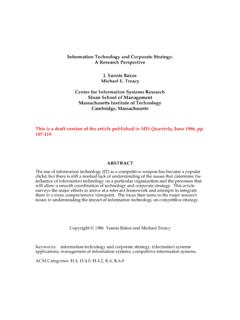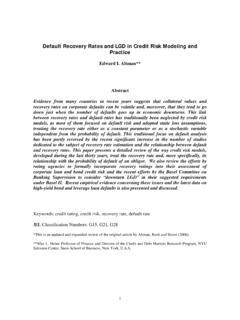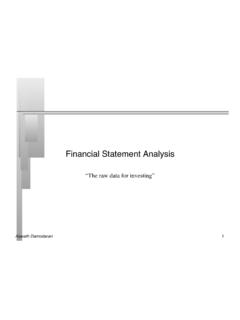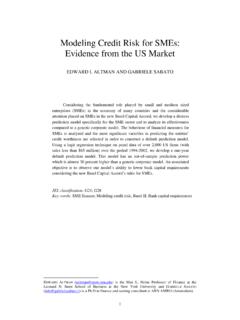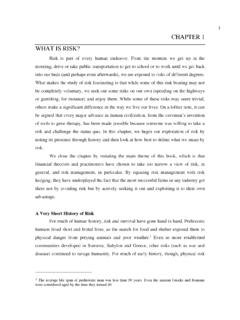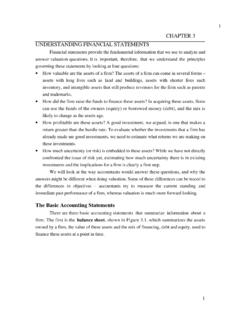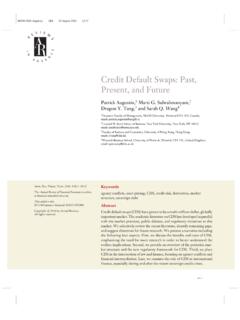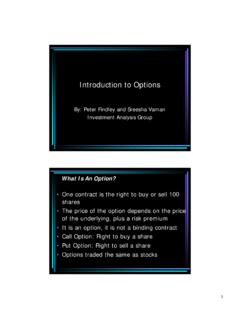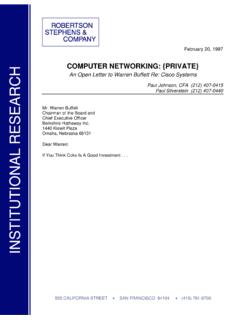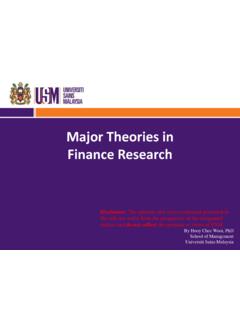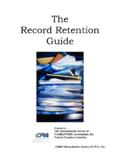Transcription of Valuation: Basics - New York University
1 Aswath Damodaran!1! valuation : Basics !Aswath Damodaran Aswath Damodaran!2!Approaches to valuation ! Intrinsic valuation , relates the value of an asset to the present value of expected future cashflows on that asset. In its most common form, this takes the form of a discounted cash flow valuation . Relative valuation , estimates the value of an asset by looking at the pricing of 'comparable' assets relative to a common variable like earnings, cashflows, book value or sales. Contingent claim valuation , uses option pricing models to measure the value of assets that share option characteristics.
2 Aswath Damodaran!3!I. Discounted Cash Flow valuation ! What is it: In discounted cash flow valuation , the value of an asset is the present value of the expected cash flows on the asset. Philosophical Basis: Every asset has an intrinsic value that can be estimated, based upon its characteristics in terms of cash flows, growth and risk. Information Needed: To use discounted cash flow valuation , you need to estimate the life of the asset to estimate the cash flows during the life of the asset to estimate the discount rate to apply to these cash flows to get present value Market Inefficiency: Markets are assumed to make mistakes in pricing assets across time, and are assumed to correct themselves over time, as new information comes out about assets.
3 Aswath Damodaran!4!Risk Adjusted Value: Three Basic Propositions The value of an asset is the present value of the expected cash flows on that asset, over its expected life: Proposition 1: If it does not affect the cash flows or alter risk (thus changing discount rates), it cannot affect value. Proposition 2: For an asset to have value, the expected cash flows have to be positive some time over the life of the asset. Proposition 3: Assets that generate cash flows early in their life will be worth more than assets that generate cash flows later; the latter may however have greater growth and higher cash flows to compensate.
4 Aswath Damodaran!5!Let s start simple: Valuing a default-free bond ! The value of a default free bond can be computed as the present value of the coupons and the face value, discounted back to today at the risk free rate. Thus, the value of five-year US treasury bond (assuming that the US treasury is default free) with a coupon rate of , annual coupons and a market interest rate of can be computed as follows: Value of bond = PV of coupons of $55 each year for 5 years @ 5% + PV of $1000 at the end of year 5 @5% = $ The value of this bond will increase (decrease) as interest rates decrease (increase) and the sensitivity of the bond value to interest rate changes is measured with the duration of the bond .
5 Aswath Damodaran!6!A little messier: Valuing a bond with default risk! When valuing a bond with default risk, there are two ways in which you can approach the problem. In the more conventional approach, you discount the promised coupons back at a default-risk adjusted discount rate. Thus, if you have a ten-year corporate bond , with an annual coupon of 4% and the interest rate (with default risk embedded in it) of 5%, the value of the bond can be written as follows: You can also value this bond , by adjusting the coupons for the likelihood of default (making them expected cash flows) and discounting back at a risk free rate.
6 Price of bond = t=1t=10 40( )t + 1,000( )10 = $ Damodaran!7!Valuing Equity! Equity represents a residual cashflow rather than a promised cashflow. You can value equity in one of two ways: By discounting cashflows to equity at the cost of equity to arrive at the value of equity directly. By discounting cashflows to the firm at the cost of capital to arrive at the value of the business. Subtracting out the firm s outstanding debt should yield the value of equity. Aswath Damodaran!8!Two Measures of Cash Flows! Cash flows to Equity: Thesea are the cash flows generated by the asset after all expenses and taxes, and also after payments due on the debt.
7 This cash flow, which is after debt payments, operating expenses and taxes, is called the cash flow to equity investors. Cash flow to Firm: There is also a broader definition of cash flow that we can use, where we look at not just the equity investor in the asset, but at the total cash flows generated by the asset for both the equity investor and the lender. This cash flow, which is before debt payments but after operating expenses and taxes, is called the cash flow to the firm Aswath Damodaran!9!Two Measures of Discount Rates! Cost of Equity: This is the rate of return required by equity investors on an investment.
8 It will incorporate a premium for equity risk -the greater the risk, the greater the premium. Cost of capital: This is a composite cost of all of the capital invested in an asset or business. It will be a weighted average of the cost of equity and the after-tax cost of borrowing. Aswath Damodaran!10!Equity valuation !AssetsLiabilitiesAssets in PlaceDebtEquityDiscount rate reflects only the cost of raising equity financingGrowth AssetsFigure : Equity ValuationCash flows considered are cashflows from assets, after debt payments and after making reinvestments needed for future growthPresent value is value of just the equity claims on the firmAswath Damodaran!
9 11!Firm valuation !AssetsLiabilitiesAssets in PlaceDebtEquityDiscount rate reflects the cost of raising both debt and equity financing, in proportion to their useGrowth AssetsFigure : Firm ValuationCash flows considered are cashflows from assets, prior to any debt paymentsbut after firm has reinvested to create growth assetsPresent value is value of the entire firm, and reflects the value of all claims on the Damodaran!12! valuation with Infinite Life!Cash flowsFirm: Pre-debt cash flowEquity: After debt cash flowsExpected GrowthFirm: Growth in Operating EarningsEquity: Growth in Net Income/EPSCF1CF2CF3CF4CF5 ForeverFirm is in stable growth:Grows at constant rateforeverTerminal RateFirm:Cost of CapitalEquity: Cost of EquityValueFirm: Value of FirmEquity: Value of EquityDISCOUNTED CASHFLOW VALUATIONL ength of Period of High Growth Aswath Damodaran!
10 13!1. Estimating Cash flow!Cash flows can be measured toAll claimholders in the firmEBIT (1- tax rate) - ( Capital Expenditures - Depreciation)- Change in non-cash working capital= Free Cash Flow to Firm (FCFF)Just Equity InvestorsNet Income- (Capital Expenditures - Depreciation)- Change in non-cash Working Capital- (Principal Repaid - New Debt Issues)- Preferred DividendDividends+ Stock BuybacksAswath Damodaran!14!2. The Determinants of High Growth!Expected GrowthNet IncomeOperating IncomeRetention Ratio=1 - Dividends/Net IncomeReturn on EquityNet Income/Book Value of EquityXReinvestment Rate = (Net Cap Ex + Chg in WC/EBIT(1-t)Return on Capital =EBIT(1-t)/Book Value of CapitalXAswath Damodaran!)
